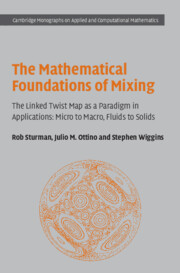 The Mathematical Foundations of Mixing
The Mathematical Foundations of Mixing Book contents
- Frontmatter
- Contents
- Preface
- Acknowledgments
- 1 Mixing: physical issues
- 2 Linked twist maps: definition, construction and the relevance to mixing
- 3 The ergodic hierarchy
- 4 Existence of a horseshoe for the linked twist map
- 5 Hyperbolicity
- 6 The ergodic partition for toral linked twist maps
- 7 Ergodicity and the Bernoulli property for toral linked twist maps
- 8 Linked twist maps on the plane
- 9 Further directions and open problems
- References
- Index
1 - Mixing: physical issues
Published online by Cambridge University Press: 03 February 2010
- Frontmatter
- Contents
- Preface
- Acknowledgments
- 1 Mixing: physical issues
- 2 Linked twist maps: definition, construction and the relevance to mixing
- 3 The ergodic hierarchy
- 4 Existence of a horseshoe for the linked twist map
- 5 Hyperbolicity
- 6 The ergodic partition for toral linked twist maps
- 7 Ergodicity and the Bernoulli property for toral linked twist maps
- 8 Linked twist maps on the plane
- 9 Further directions and open problems
- References
- Index
Summary
This chapter provides a brief review of physical considerations in the analysis of mixing problems and several examples of problems that can be framed in terms of the mathematical structure covered in this book.
Mixing is a common phenomenon in everyday life. A blob of white cream placed in a cup of black coffee and gently stirred with a spoon forms, if one looks carefully, intricately shaped striated structures, until the mixture of coffee and cream homogenizes into a fluid that is uniformly brown in colour. This common phenomenon serves to illustrate some of the key features of mixing; namely, the interplay between advection and diffusion. If the coffee is at rest when the cream is added (and assuming that the insertion of the cream into the coffee only causes negligible disturbance of the surrounding coffee) then, in the absence of stirring, the cream mixes with the coffee by the mechanism of molecular diffusion. Experience tells us that in this particular situation the mixing takes much longer than we would typically be willing to wait. Therefore we stir the admixture of coffee and cream with a spoon, and observe it to homogenize very quickly. This stirring illustrates the role that advection plays in homogenizing the cream and coffee. In fact, in this particular example (as well as many others) the role of molecular diffusion in achieving the desired final mixed state may very well be negligible.
- Type
- Chapter
- Information
- The Mathematical Foundations of MixingThe Linked Twist Map as a Paradigm in Applications: Micro to Macro, Fluids to Solids, pp. 1 - 30Publisher: Cambridge University PressPrint publication year: 2006
- 2
- Cited by
